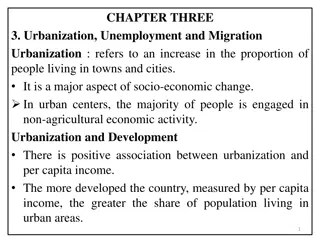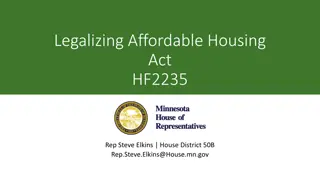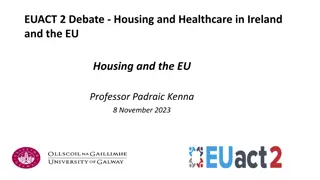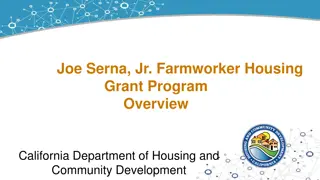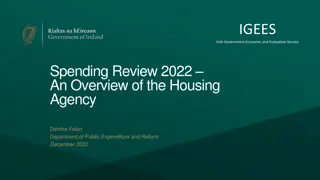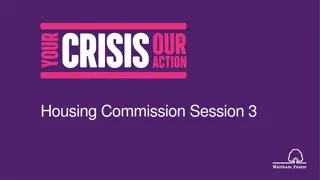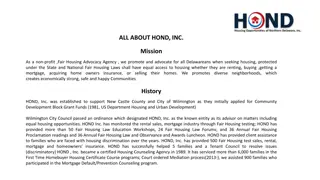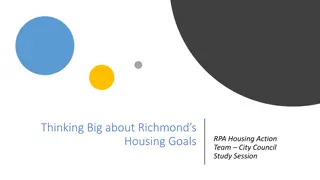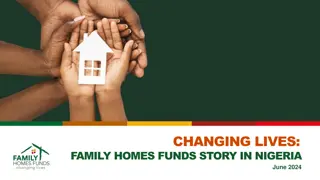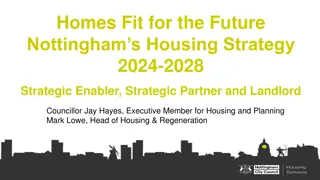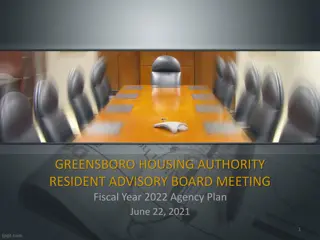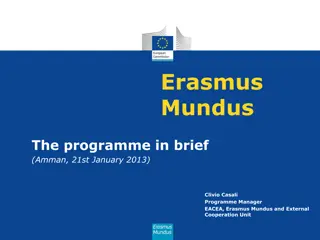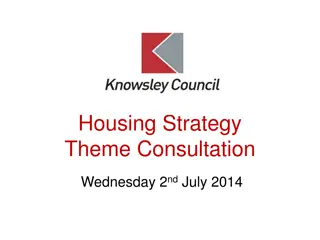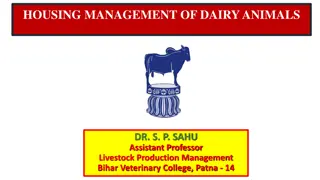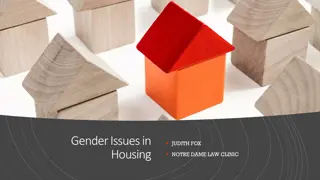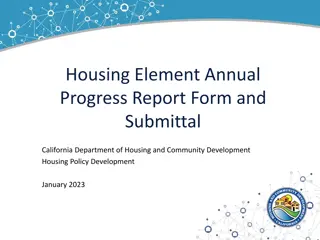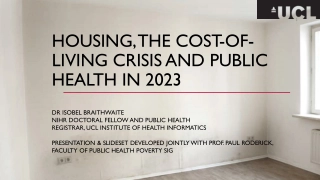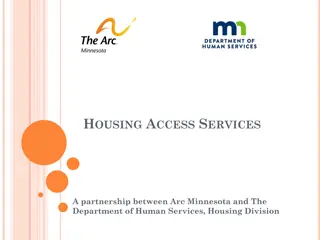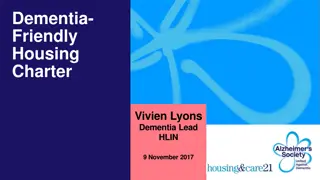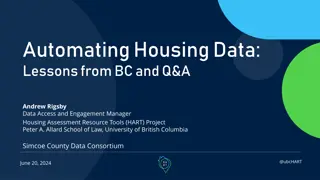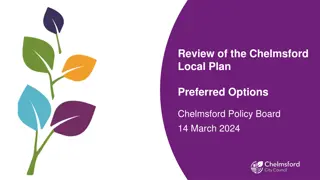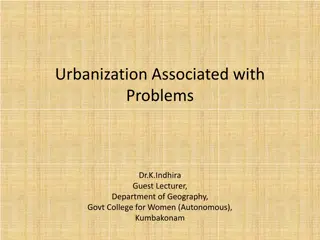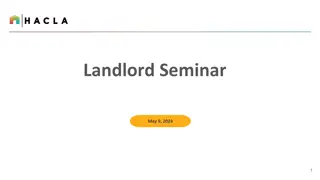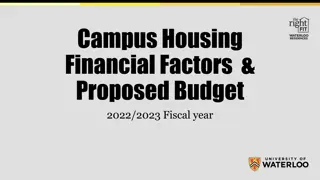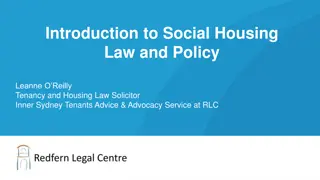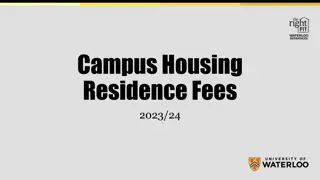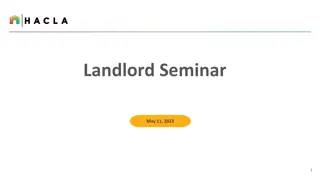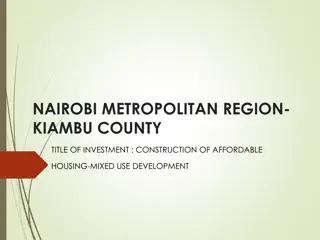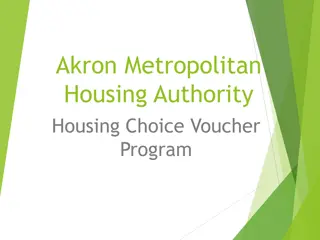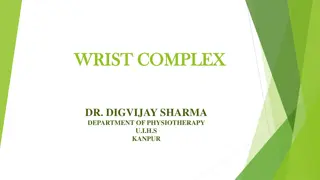Sustainable Urbanization and Housing Programme Joint Review Meeting Overview
The Ministry of Lands, Housing, and Urban Development led the Sustainable Urbanization and Housing Programme review meeting in November 2021. Stakeholders gathered to assess past performance, set budget priorities, and strategize for future improvements. Key objectives included evaluating achievements, sharing insights, and gaining stakeholder support for enhanced service delivery in Uganda.
Download Presentation

Please find below an Image/Link to download the presentation.
The content on the website is provided AS IS for your information and personal use only. It may not be sold, licensed, or shared on other websites without obtaining consent from the author. Download presentation by click this link. If you encounter any issues during the download, it is possible that the publisher has removed the file from their server.
E N D
Presentation Transcript
MINISTRY OF LANDS, HOUSING AND URBAN MINISTRY OF LANDS, HOUSING AND URBAN DEVELOPMENT DEVELOPMENT lead agency for the lead agency for the Sustainable Urbanization and Housing Programme Sustainable Urbanization and Housing Programme KEY ACTION AREAS FROM THE JOINT PROGRAMME REVIEW MEETING OF 11THNOVEMBER 2021 By Programme Secretariat
Introduction The Joint Programme Review (JPR) meeting is an Annual review activity where stakeholders come together to review past performance, understand the current trend of events and agree on the course of action for the future. In Compliance with this requirement, the Sustainable Urbanization and Housing Programme review took place on 11thNovember 2021 in Mestil Hotel Kampala. The Joint Programme Review for FY 2020/21 was organized in a hybrid manner i.e. both physical and virtual due to covid19 restrictions so as to give an opportunity for all stakeholders to participate in the process.
Joint Programme Meeting Theme Joint Programme Meeting Theme Sustainable Urbanization and Housing, The Programme for Socio- Economic Transformation of Uganda .
Objectives and Purpose of the JPR Objectives and Purpose of the JPR To Review programme performance for 2020/21 To discuss and agree on key budget strategies/priorities for FY 2022/23, and the Medium term To discuss, develop and agree on strategies to improve the performance of the Programme Undertake an assessment of the programme and agree upon the achievable and practical agenda for the future To provide a forum for sharing experiences and lessons learnt from the International, National, Regional, and District and Local Government levels To provide policy and strategic guidance to the Programme stakeholders To enlist stakeholder support to the programme for better delivery of services to the people of Uganda
Expected JPR Activity Results/Deliverables Expected JPR Activity Results/Deliverables Agreed strategies and activities with responsibility centres Clear roadmap on the next course of action and steps in delivering the programme results Harmonized Budget Strategy/Priorities for FY 2022/23 and Medium Term Guided road map to achieving the Programme objectives and mandate upon Resolutions with actionable
Key Resolutions/ Action areas agreed Upon Issues Resolution/Way-forward Progress to date No Responsible Center Timeline The Secretariat organized a Programme Working Group (PWG) Meeting on 10 March, 2022 in which all MDAs were invited and involved. Continuous engagements with the different stakeholders under the Programme such as the UDPG, NHCC, HFB, KCCA, UFZA etc on implementation and reporting of key interventions under their respective Institutions. I. There is need for active engagement of the other MDAs for effective achievement of the results and outcomes for the SU&H program There is need for harmonious working relationships between stakeholders in the SU&H program Inadequate stakeholder participation and involvement 1. PS/ MLHUD Immediate II. The Secretariat organized a Projects Review Workshop from 1 7 March, 2022 to review and align all project concepts to the SUHP. New and proposed projects should be aligned to the program results framework for effective attainment of SU&H program results. Head Secretariat SU&H program Non alignment of some projects to the NDPIII 2. Immediate Letters requesting for nomination of members to the Multi-Sectoral Committee were delivered to the different MDAs. The first sitting of the Committee is expected to be in July 2022. Non reportage on NDPIII key result areas & targets achieved i. A multi-sectoral committee should be constituted to coordinate SU&H program planning, implementation and reporting on program results. 3. PS/MLHUD 2weeks
Key Resolutions/ Action areas agreed Upon Contd Key Resolutions/ Action areas agreed Upon Cont d No Issues Resolution/Way-forward Progress to date Responsible Center Timeline ii. Future presentations during U&H JRM should highlight progress on attainment of targets in the NDPIII (trend analysis) Head Secretariat SU&H program 1year This was adopted in use Adopt comprehensive and new terminologies in Solid waste i.e. Solid-waste management instead of solid waste disposal; solid waste use full materials The use of the terminology: Solid waste disposal SU&H actors / stakeholders Immediate 4. The Ministry has continuously engaged the UDPG on SUHP Limited flow of information between SU&H and the development partners Organize a meeting between SU&H program and the Development partners to share information regarding the program PS/MLHUD Immediate 5.
Key Resolutions/ Action areas agreed Upon Contd Key Resolutions/ Action areas agreed Upon Cont d Progress to date No Issues Resolution/Way forward Responsible Center Timeline Engagement with MFPED still ongoing. Lobby government to exempt SU&H budget cuts on the account of consumptive charges Engage NPA, MFPED and Cabinet to remove the Lands Sub-Program from the Natural Resources Program and include it under the SU&H Program Minister LHUD Budget cuts Immediate 6. The Head of the Programme communicated with NPA and MFPED on the matter. Awaiting guidance from them. Monitoring and Evaluation of Projects has been strengthened to foresee their fast tracking. Inclusion of the Lands Sub Program to SU&HP Minister, PS Immediate 7. Fast tracking Implementati on of projects Fast track project in pipeline 8.
Budget Strategy for FY 2022/23 Budget Strategy for FY 2022/23 Develop and implement integrated physical development plans for the new cities and issue guidelines for their operationalisation Develop and implement an investment plan for adequate and affordable housing; Development and implement bankable projects in line with GKMA Strategy. 9
Public Sector Costing and Financing of NDP3 (Ushs Bn) Public Sector Costing and Financing of NDP3 (Ushs Bn) FY 2020/21 Actual FY 2021/22 Actual Total FY 2022/23 Proj FY 2023/24 Proj FY 2024/15 Proj 4,356 833 825 952 840 907 Cost 831.72 219.57 124.91 345.79 70.95 70.5 Actual -3,524 -613 -700 -606 -769 -837 Gap 10
Key Physical Planning Action Areas/Activities Key Physical Planning Action Areas/Activities Development of Regional and District Physical Development Plans (UGX 18.75 Bn) Preparing detailed plans Action area plans Translating plans Capacity building for all Physical Planning Actors (UGX 11.25 Bn) Tailored training Tools and Software development System development, Research and Development (UGX 15 Bn)
Key Urbanization Action Areas/Activities Key Urbanization Action Areas/Activities Reform and improvement of business processes in Cities and other Urban Areas through rollout of the Integrated Revenue Management System (UGX 11.25 Bn) Develop and implement integrated Physical and Economic Plans for Cities and Other Urban Areas (UGX 9.375 Bn) Infrastructure improvement in cities and other Urban Areas (UGX 750 Bn)
Key Housing Action Areas/Activities Key Housing Action Areas/Activities Slum upgrading or redevelopment (UGX 262.5 Bn) Slum Profiling Capacity development for slum dwellers Incremental developments Support for Housing Cooperative development (UGX 7.875 Bn)
Key areas of Support from DPs Key areas of Support from DPs Provide technical support to sectors in planning and implementation of PIAP interventions Provide Financial resource for implementation of the PIAPs Integrate some aspects of PIAPs into their programming thereby contributing to their implementation Participate in PWG activities as co-opted members Provide information about their on-going and planned development activities to the sector for input into the PIAPs Support and participate in M&E of PIAPs.
Key Conclusion points Key Conclusion points Enhance advocacy for public financing. However, this should be based on clearly defined interventions. Mobilisation of alternative sustainable financing such as PPPs, Private Sector and other stakeholders. Mobilise other development partners through formulation of bankable projects; 15
Final Remark Final Remark In order to realize the successful implementation of the PIAP, all stakeholders need to actively participate. As our key stakeholders under the Programme, we call upon you to actively participate.
The End The End Thank You 17



